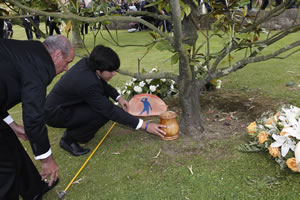Seve’s Gone, But Impact Remains

Wednesday - May 18, 2011
| Share
 Del.icio.us
Del.icio.us
|
The Spanish flag at the World Golf Hall of Fame is being flown at half-staff. Just as the scarlet and gold ensigns were at the Spanish Open, the Players Championship and no doubt at golf courses through out Europe.
When the news was announced that Seve Ballesteros had taken an unexpected turn for the worse, shock ran through the tournament at the Real Club de Golf El Prat in Barcelona, changing the event from a celebration to a memorial. Jose Maria Olazabal, who paired with Ballesteros to make the most dominant pairing in Ryder Cup history, and Miguel Angel Jimenez were beside themselves with grief. Their hearts too broken to do anything but weep, the pair refused all efforts to speak of their rounds or their suddenly ill friend. Hours later the most important person in European golf was gone. Dead at the age of 54 after a long battle with brain cancer.
As Lee Westwood said, golf has “lost an inspiration, genius, role model, hero and friend.” Olazabal cried on the practice range the next day.
It’s hard to over-emphasize the Spaniard’s impact on the game. Besides Arnold Palmer, no one had a bigger impact on the sport than Ballesteros. While Gary Player brought top flight golf to nearly every corner and Tiger Woods brought excitement to a sport many thought too boring to warrant attention, Ballesteros inspired an entire continent to reach sports’ greatest heights.
Spanish Prime Minister Jose Luis Rodriguez Zapatero said Ballesteros was the nation’s most visible person as it emerged from the dictatorship of Gen. Francisco Franco. “He was a symbol of the new, democratic Spain,” said Zapatero to reporters in Madrid. “Open to the world, without complexes, and capable of being up there with the best in any discipline, including those we had hardly any tradition of, like golf.”
Seve’s success came not just from his immense talent, but also pride and a fierce competitive spirit rarely seen in his sport. As he once famously said of his prematch routine: “I would look my opponent in the eye, shake his hand, pat him on the back and wish him luck all the while thinking, “I’m going to bury you.”
He willed not only himself to victory but forced the best out of those around him.
Ballesteros had to be talked into playing in the Ryder Cup but once he accepted he became Europe’s driving force. He scolded his teammates for hanging their heads after losing to the U.S. by a point in 1983. “That was the spark, said Nick Faldo years later. “By 1985, we knew we could do it, we could win the Ryder Cup.”
That burning desire to win didn’t always sit well with opponents or even the European Tour, which he once referred to as the PGA Mafia after refusing to accept a penalty for slow play.
In 1991 Ballesteros referred to the American team as “11 nice guys and Paul Azinger.”
Azinger responded, saying, “The king of games-manship doesn’t like me? Good. A feather in my cap.”
Ballesteros would do anything to win. That same year he made chocking sounds as he ate a piece of cake while competitor and good friend Nick Price was in the middle of his back-swing. So often did Seve seem to have a throat ailment during the Ryder Cup that some opponents carried cough drops in mock support. As European captain for the 1997 Ryder Cup at Valderrama Golf Club in Spain, he had certain greens mowed during the rounds without telling the Americans.
But for all his nastiness at times, his talent was such that even those he upset could not help but admire his game. Ballesteros was the greatest scrambler in the history of the sport. He routinely turned bad drives into remarkable scoring opportunities. It didn’t matter if he was behind a bush, under a tree, in a parking lot, on a thin lie or in the deepest U.S. Open rough, everyone knew he would find a way to get up and down.
He was Palmer with a tan and Mickelson with a washboard stomach.
Ballesteros won 87 times worldwide and five majors.
If not for a bad back and his willingness to carry European golf on his shoulders, he surely would have won more. As Faldo has said, “Even the mightiest can only go so often to the well for inspiration, and the Ryder Cup took plenty from Seve’s life battery.”
For nearly three years Ballesteros fought cancer with as much determination and class as anyone can. In the process he reminded everyone of the fire that made him a champion.
“I’ve had a very good life. I’m sure that some people will feel sorry for me or maybe cry when they see this,” he said in a BBC interview in October.
“But I feel very happy and a very lucky person because throughout my life I have had so many great moments and I feel that I lived two or three more lives than the average person.
“This thing that happened to me is a very little thing compared to other people who have tougher times. They didn’t have the opportunity to live life so intensely and as well as I did.”
E-mail this story | Print this page | Comments (0) | Archive | RSS Comments (0) |
Most Recent Comment(s):













